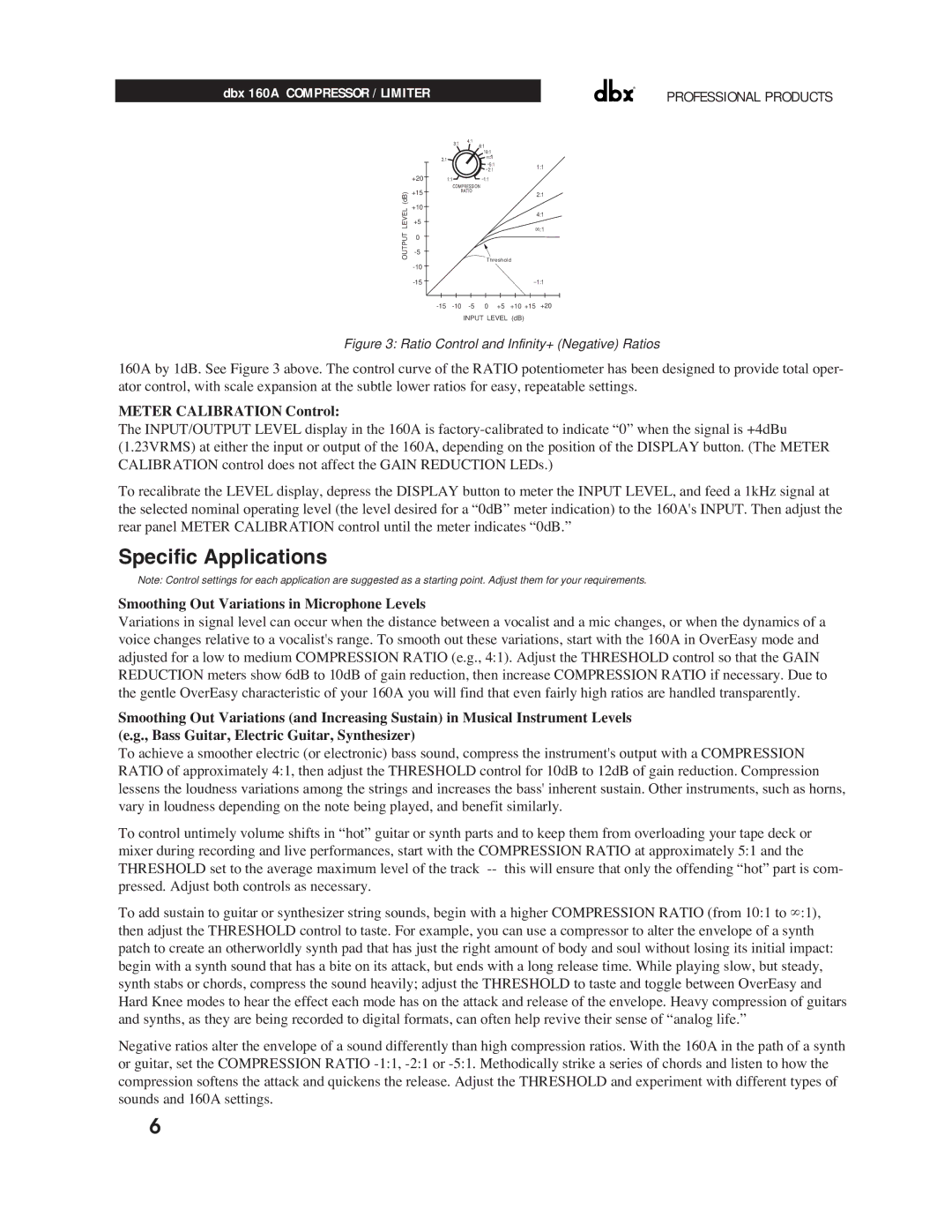
dbx 160A COMPRESSOR / LIMITER
+20
(dB) | +15 | |
+10 | ||
LEVEL | ||
+5 | ||
OUTPUT | 0 |
®
PROFESSIONAL PRODUCTS
∞![]()
−
−1:1
−![]()
![]()
![]()
2:1
4:1
∞:1
Threshold
−1:1
INPUT LEVEL (dB)
Figure 3: Ratio Control and Infinity+ (Negative) Ratios
160A by 1dB. See Figure 3 above. The control curve of the RATIO potentiometer has been designed to provide total oper- ator control, with scale expansion at the subtle lower ratios for easy, repeatable settings.
METER CALIBRATION Control:
The INPUT/OUTPUT LEVEL display in the 160A is
To recalibrate the LEVEL display, depress the DISPLAY button to meter the INPUT LEVEL, and feed a 1kHz signal at the selected nominal operating level (the level desired for a Ò0dBÓ meter indication) to the 160A's INPUT. Then adjust the rear panel METER CALIBRATION control until the meter indicates Ò0dB.Ó
Specific Applications
Note: Control settings for each application are suggested as a starting point. Adjust them for your requirements.
Smoothing Out Variations in Microphone Levels
Variations in signal level can occur when the distance between a vocalist and a mic changes, or when the dynamics of a voice changes relative to a vocalist's range. To smooth out these variations, start with the 160A in OverEasy mode and adjusted for a low to medium COMPRESSION RATIO (e.g., 4:1). Adjust the THRESHOLD control so that the GAIN REDUCTION meters show 6dB to 10dB of gain reduction, then increase COMPRESSION RATIO if necessary. Due to the gentle OverEasy characteristic of your 160A you will find that even fairly high ratios are handled transparently.
Smoothing Out Variations (and Increasing Sustain) in Musical Instrument Levels (e.g., Bass Guitar, Electric Guitar, Synthesizer)
To achieve a smoother electric (or electronic) bass sound, compress the instrument's output with a COMPRESSION RATIO of approximately 4:1, then adjust the THRESHOLD control for 10dB to 12dB of gain reduction. Compression lessens the loudness variations among the strings and increases the bass' inherent sustain. Other instruments, such as horns, vary in loudness depending on the note being played, and benefit similarly.
To control untimely volume shifts in ÒhotÓ guitar or synth parts and to keep them from overloading your tape deck or mixer during recording and live performances, start with the COMPRESSION RATIO at approximately 5:1 and the THRESHOLD set to the average maximum level of the track
To add sustain to guitar or synthesizer string sounds, begin with a higher COMPRESSION RATIO (from 10:1 to °:1), then adjust the THRESHOLD control to taste. For example, you can use a compressor to alter the envelope of a synth patch to create an otherworldly synth pad that has just the right amount of body and soul without losing its initial impact: begin with a synth sound that has a bite on its attack, but ends with a long release time. While playing slow, but steady, synth stabs or chords, compress the sound heavily; adjust the THRESHOLD to taste and toggle between OverEasy and Hard Knee modes to hear the effect each mode has on the attack and release of the envelope. Heavy compression of guitars and synths, as they are being recorded to digital formats, can often help revive their sense of Òanalog life.Ó
Negative ratios alter the envelope of a sound differently than high compression ratios. With the 160A in the path of a synth or guitar, set the COMPRESSION RATIO
6
